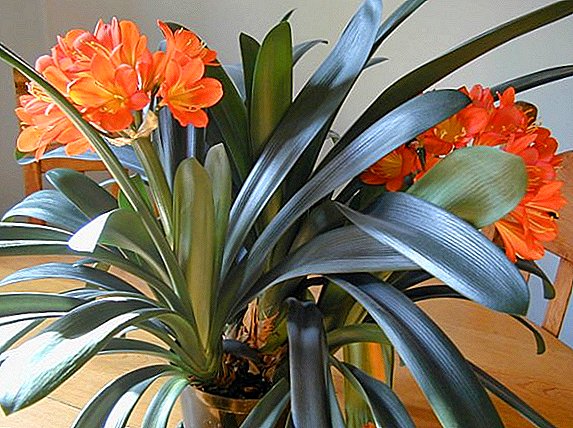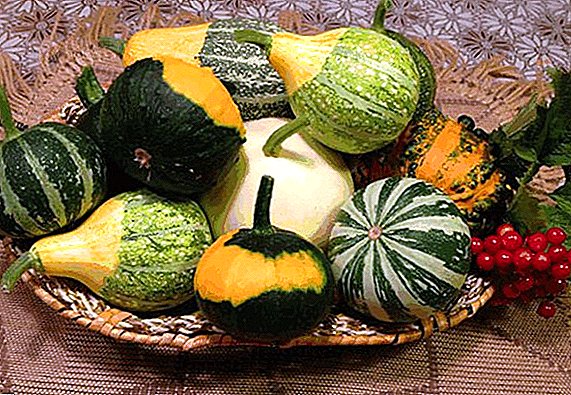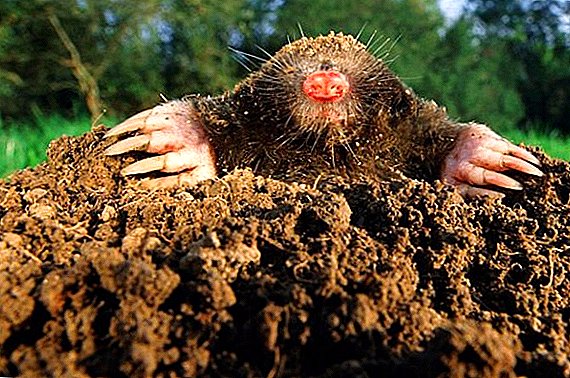 Moles, as well as shrews and hedgehogs, belong to the order of insectivores. They live mainly in areas with wet or constantly damp lands - in meadows, in floodplains of rivers, on the edges of deciduous and mixed forests. Mole is often settled in our garden or garden. Since here everywhere there is a ground loosened by digging, teeming with earthworms, and digging in the ground love to settle in such rich hunting grounds. In the pliable soil of the garden, the animal often does not throw open ground into the surface piles, but presses it, pressing it into the walls of the course. As a result, the settlement of a new tenant in the garden is difficult to see with the naked eye.
Moles, as well as shrews and hedgehogs, belong to the order of insectivores. They live mainly in areas with wet or constantly damp lands - in meadows, in floodplains of rivers, on the edges of deciduous and mixed forests. Mole is often settled in our garden or garden. Since here everywhere there is a ground loosened by digging, teeming with earthworms, and digging in the ground love to settle in such rich hunting grounds. In the pliable soil of the garden, the animal often does not throw open ground into the surface piles, but presses it, pressing it into the walls of the course. As a result, the settlement of a new tenant in the garden is difficult to see with the naked eye.
Meet the underground resident
The animal is perfectly adapted to underground habitat.  Velvet fur coat with a short, but thick and soft fur protects the mole's sides from contact with the tamped walls of underground tunnels. The brisk little body of the animal and its spatulate forepaws, in combination with the nose-proboscis, make it possible to move quickly under the soil surface. The front five-fingered paws are equipped with a false bone sixth spatula, as well as long and sharp claws, which take the most direct part in the digging of tunnels.
Velvet fur coat with a short, but thick and soft fur protects the mole's sides from contact with the tamped walls of underground tunnels. The brisk little body of the animal and its spatulate forepaws, in combination with the nose-proboscis, make it possible to move quickly under the soil surface. The front five-fingered paws are equipped with a false bone sixth spatula, as well as long and sharp claws, which take the most direct part in the digging of tunnels.
The palms of the hand are turned with the back of the hand inward, and with the palms outward. A large head in relation to the body sits on a muscular neck. The head and neck of the underground resident is its main driving force. A capacious description of the mole of an ordinary man is a sort of living earthly auger.  The mole has no ears, the auditory holes are covered with skin from falling into them of earth and debris. The eyes of the animal are small and blind-eyed. Despite the absence of auricles in the underground resident, he has an excellent ear. In combination with a sensitive sense of smell and a well-developed sense of touch, this allows him to be a good hunter. For the shape of the teeth, the animal is sometimes jokingly called the "underground crocodile" - they are very sharp and have the shape of a cone.
The mole has no ears, the auditory holes are covered with skin from falling into them of earth and debris. The eyes of the animal are small and blind-eyed. Despite the absence of auricles in the underground resident, he has an excellent ear. In combination with a sensitive sense of smell and a well-developed sense of touch, this allows him to be a good hunter. For the shape of the teeth, the animal is sometimes jokingly called the "underground crocodile" - they are very sharp and have the shape of a cone.
Swarm is new and new tunnels, the worker spends a lot of energy, so he constantly has to feed the body. The amount of food eaten at one time reaches 30 grams. If we consider that eating a mole several times a day, the weight of the food it absorbs sometimes exceeds the weight of the hunter himself. The animal not only eats a lot, but also drinks a lot. Therefore, without fail, one of his tunnels leads to a source of moisture (a stream that does not dry out in a puddle, a flowing water tap).
Important! The animal does not stop hunting for food, even in winter. The search for worms in the winter period is facilitated by the fact that attracted by the warmer air of the tunnels and the musky smell of the inhabitants of the burrow, the worms themselves crawl out into the underground passages.
The scheme of underground tunnels
The underground mole labyrinth system consists of two types of moves:
- Feed tunnels - such moves are located near the ground surface (3-5 cm) and are used to collect worms and large and small insects. The mole continuously runs through the feeding tunnels and gathers the harvest.
- Permanent tunnels - are located much deeper, at a depth of 15-20 cm deep into the soil.
When animals dig new tunnels, a mass of freshly dug soil is formed, which is simply nowhere to go in the cramped ground of the earth. Therefore, the animal in the process of digging its head pushes a new ground to the surface. It is difficult for an observer to notice what is happening underground, and only the soil that begins to move can report that a mole works under it. Initially, there is a barely noticeable stirring of the earth, but with each new portion of the arriving soil, the mound of moist earth becomes higher.  During the day, a tireless worker breaks through in our gardens and gardens up to 20 meters of new tunnels. Any branching motion starts from a wide main passage that leads to an underground nest. Collection of caught prey and hunting for new prey continues around the clock. The fact that the hunter does not eat, he postpones the future; for this, there is a nook near the main nesting chamber where stocks are stored.
During the day, a tireless worker breaks through in our gardens and gardens up to 20 meters of new tunnels. Any branching motion starts from a wide main passage that leads to an underground nest. Collection of caught prey and hunting for new prey continues around the clock. The fact that the hunter does not eat, he postpones the future; for this, there is a nook near the main nesting chamber where stocks are stored.
The nesting chamber itself is made very soundly, with solid, non-crumbling walls and a bed covered with soft and dry grass. It is surrounded by two circular tunnels that connect with each other and with the nest. Usually a mole does not have its shelter in open space, but tries to cover it deeply under the roots of a tree or shrub. This underground house serves him and shelter from enemies and a place to relax and raise kids.  A female underground hunter brings from three to eight cubs. Young feed on maternal milk for a short time, 30 days after birth, they begin to independently get out of the maternal nest and hunt in old tunnels laid by their parents. After 50-60 days after birth, animals reach the size of their parents and soon leave for independent life.
A female underground hunter brings from three to eight cubs. Young feed on maternal milk for a short time, 30 days after birth, they begin to independently get out of the maternal nest and hunt in old tunnels laid by their parents. After 50-60 days after birth, animals reach the size of their parents and soon leave for independent life.
Did you know? Mole speed through the labyrinth of underground passages reaches more than 50 meters per minute. He is able to run, without losing speed, change the direction of motion on the opposite. An assistant in such a speed run is his fur, which is easily placed in the direction opposite to the direction of the run.
What moles eat
There is a perception that moles are vegetarians and feed on the roots of cultivated plants in a vegetable garden or flower bulbs in flower beds. This is fundamentally wrong, moles are predatory animals. The menu of underground hunters consists of bears, larvae of the May beetle, large and small insects, and worms.  This animal is small, but with a very well-developed musculature, reinforced by constant hard excavation work, so it can successfully attack a frog, a mouse or a snake that has fallen into an underground tunnel. Not only to attack, but also to win in this fight, and have dinner for an unexpected visitor. Rapid metabolism in the body of an animal requires constant replenishment of vitality with calories, and the mole is forced to live in order to eat. His whole life is a constant hunt for food.
This animal is small, but with a very well-developed musculature, reinforced by constant hard excavation work, so it can successfully attack a frog, a mouse or a snake that has fallen into an underground tunnel. Not only to attack, but also to win in this fight, and have dinner for an unexpected visitor. Rapid metabolism in the body of an animal requires constant replenishment of vitality with calories, and the mole is forced to live in order to eat. His whole life is a constant hunt for food.
What moles eat at their summer cottage:
- caught mice;
- frogs and toads;
- larvae of butterflies and May beetles;
- big and small bear;
- worms.
Important! Moles dig the ground only with their paws, they cannot gnaw at it with their teeth, so they prefer to settle in soft, loose soil.
In the forest one can less often see the mounds of mole minks, there for the normal underground movement of the animal an obstacle arises in the form of often twisted adult tree roots. Some species of moles may hunt on the surface, but this is more likely an exception. Moles in the forest feed on what they manage to get on hunting: very small animals, amphibians and insects. 
Moles in the garden
It is considered to be a mole as a useless pest who needs to be scared away from the garden plot by all means. However, this opinion is greatly exaggerated.
Learn how to get a vole from the dacha.
Benefit
I would like to say a few words in defense of the underground worker: he does not spoil the harvest potato or beet, as do Medvedka or Khrushchi.
An underground resident who settled in the garden regulates the number of harmful insects, reducing them to a minimum number. It loosens the soil, so that through its minks water and air enter the soil, to the roots of plants. The hunter catches and punctures the mouse colony living in the country, which just destroys the flower bulbs and eats potatoes in the garden beds.  Nevertheless, one mole settled in the garden will cause less damage to plantings than bred bears. If gardeners saw that a mole eats under the ground, the animal would have been thanked for a long time. After all, damn bears do not cope with poisons or traps, and from one nest in two months almost a thousand new bears will hatch and crawl all over the garden. If you do not fight this scourge, you will soon have to leave the garden, as it will be impossible to wait for the harvest.
Nevertheless, one mole settled in the garden will cause less damage to plantings than bred bears. If gardeners saw that a mole eats under the ground, the animal would have been thanked for a long time. After all, damn bears do not cope with poisons or traps, and from one nest in two months almost a thousand new bears will hatch and crawl all over the garden. If you do not fight this scourge, you will soon have to leave the garden, as it will be impossible to wait for the harvest.
Did you know? The mole possesses valuable fur, fur coats and caps are sewn from it. Animals molt twice a year, after autumn molt their fur becomes smooth, velvety, brilliant and opens the hunting season to the mole. Underground hunter is very lucky that his fur, though beautiful, but very short-lived. Therefore, the demand for its skins is small.
Harm
But even considering that the moles do not feed on the roots of cultivated plants, their appearance causes mechanical damage to landings - the roots of the plants get into the open air, become bare, wither and shrink.
Underground predator destroys many insect-killing gardens. But at the same time, the mole, constructing its underground communications, damages the root system of large and small plants. The system of tunnels permeates the entire suburban area, when they are laid, the animal can dig a course in the cellar or outdoor toilet. In the dry season, there is no big trouble in this, but as soon as the autumn rains begin, it will flood the cellar through such an underground passage and it will become unsuitable for further storage of stocks for the winter.  And what the mole eats in vegetable gardens can also directly harm the plants planted there. After all, the soil in which there are no earthworms is dead soil and it does not produce a good harvest. Worms loosen the garden soil, through the course of earthworms oxygen and moisture (dew, rainwater) penetrate the soil. Laying their underground roads, the burrowing animal literally throws out the plants (potatoes, carrots, beets) planted in it from the soil. In the garden, where the mole bumps appeared, everything around them is littered with falling and drying plants.
And what the mole eats in vegetable gardens can also directly harm the plants planted there. After all, the soil in which there are no earthworms is dead soil and it does not produce a good harvest. Worms loosen the garden soil, through the course of earthworms oxygen and moisture (dew, rainwater) penetrate the soil. Laying their underground roads, the burrowing animal literally throws out the plants (potatoes, carrots, beets) planted in it from the soil. In the garden, where the mole bumps appeared, everything around them is littered with falling and drying plants.
When laying their moves, a tireless worker gives out mounds of soil to the surface of the lawn, which, having settled a little, harden and make it difficult to mow the grass on such a lawn. With its "improvements" the harmful animal here and there makes its own adjustments to the landscape design of the dacha, sprinkling its mounds on gravel paths and alpine hills.  Moles love to settle in places like holiday plots or rural house. Here the soil is much softer, more luxurious and not as hard as on the floodplain meadows. If an unwelcome guest settled in your yard, you need to set traps or traps. In case you do not want to damage the worker, you can install a mole repeller. Devices are electronic (which produce an unpleasant ultrasound for an animal) or chemical ones that are laid in a burrow.
Moles love to settle in places like holiday plots or rural house. Here the soil is much softer, more luxurious and not as hard as on the floodplain meadows. If an unwelcome guest settled in your yard, you need to set traps or traps. In case you do not want to damage the worker, you can install a mole repeller. Devices are electronic (which produce an unpleasant ultrasound for an animal) or chemical ones that are laid in a burrow.
Chemical repellers drive the animal away from the occupied territory. They have a sharp, unpleasant smell. The builder of the underground passages will not go far - most likely, he will move his tunnels to the neighboring site.
Read also about how to protect the apple from hares.
Does winter hibernate
Since the temperature in the underground is much higher than on the surface of the ground, the system of underground tunnels is quite warm and the animal feels comfortable. In winter, the mole eats the same as it usually does: there is enough food in the ground (sleeping bugs, worms, wood lice, larvae). During the cold season, the mole's activity subsides a bit, and in between insect hunting, the animal sleeps in its nesting place. Since the voracious mole cannot do without food for longer than 14-16 hours, it has to constantly hunt. But if the winter is harsh and the earth freezes over more than half a meter, the insects hibernating in it freeze and the mole dies without feeding. 
Who eats them
Despite the fact that moles live underground and are very difficult prey, they also have enemies in the animal world. They are happy to hunt foxes, raccoon dogs and ordinary dogs. And even the yard cat will not miss the moving mound of earth and will try to catch its inhabitant. However, none of these animals feed on moles and will not eat a captured mole, since this animal has a very strong musky smell. It serves as a reliable defense - few predators are so unintelligible.
However, in the animal world there is a predator, who with pleasure catches and eats unpleasant-smelling diggers. This nimble agile enemy is a weasel.  Such a curious underground beast often lives in the same yard with us. And even if we do not notice it, but with its existence and vital activity it brings both a little harm and a lot of benefit for a person. Already, people have learned to coexist with their silent country house neighbors. For all living beings, large and small, there is a place in this world.
Such a curious underground beast often lives in the same yard with us. And even if we do not notice it, but with its existence and vital activity it brings both a little harm and a lot of benefit for a person. Already, people have learned to coexist with their silent country house neighbors. For all living beings, large and small, there is a place in this world.












